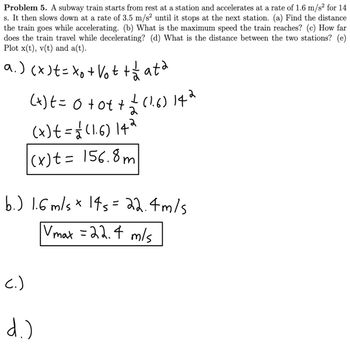
College Physics
11th Edition
ISBN: 9781305952300
Author: Raymond A. Serway, Chris Vuille
Publisher: Cengage Learning
expand_more
expand_more
format_list_bulleted
Concept explainers
Topic Video
Question
I'm having trouble solving for c and d. The answer key says: c.) 71.7 m and d.) 228.5 m

Transcribed Image Text:Problem 5. A subway train starts from rest at a station and accelerates at a rate of 1.6 m/s² for 14
s. It then slows down at a rate of 3.5 m/s² until it stops at the next station. (a) Find the distance
the train goes while accelerating. (b) What is the maximum speed the train reaches? (c) How far
does the train travel while decelerating? (d) What is the distance between the two stations? (e)
Plot x(t), v(t) and a(t).
a.) (x ) == xo +Vot + á mata
(x) == 0 +0++ == (1.6) 142
(x) t = =√√ (1.6) 14 ²
2
2
(x) t = 156.8m
b.) 1.6 m/s * 145 = 22.4m/s
Vmax = 22.4 m/s
(.)
d.)
Expert Solution
This question has been solved!
Explore an expertly crafted, step-by-step solution for a thorough understanding of key concepts.
This is a popular solution
Trending nowThis is a popular solution!
Step by stepSolved in 3 steps with 2 images

Knowledge Booster
Learn more about
Need a deep-dive on the concept behind this application? Look no further. Learn more about this topic, physics and related others by exploring similar questions and additional content below.Similar questions
- 4. Suppose you leave you house, hike 2.0 mi due east, then 3.0 mi due north, and then 6.0 miles 30 north of west to your favorite tree. Find the total displacement, magnitude and direction, from your house to the tree. 6 mi 30° 2m² 3 miarrow_forward4. A plane traveling at 192 km/h [N] is blown eastward by the wind with a speed of 56.0 km/h. What is the velocity of the plane with respect to the ground? a. 1.36 x102 km/h [E 16.3o S]b. 2.00x102 km/h [N 16.3o E]c. 2.00x102 km/h [N 73.7o E]d. 2.48x102 km/h [E 73.7o S]e. 1.36 x102 km/h [N 73.7o E]arrow_forwardS Math with Units Introduction to Physics # 3 20 54 Which UNIT will the answer to this operation have? (We're only interested in the units, not the number.) If the operation is not valid, choose "Not Valid" 5 m.s 2 s² © 2003-2023 International Academy of Science. All Rights Reserved. MAR 20 000 A) m.s³ B) / % je in E E Acellus Learning System 5 F5 6 tv ♫ F6 & 7 C) m S D) Not Valid F7 NA * C ➤11 F8 Enter S F9 exec C F10arrow_forward
- Just need D and E A) 0.0517 m/s^2 B) 5.37 N C) 4.8076 Narrow_forwardpart c and d for physics 250arrow_forward9. Car A is driving east on the highway, traveling at 21.66ms. Car B is driving east on the same highway and passes Car A. Car B is traveling at 23.01ms. If you are sitting in Car A, what is the speed of Car B from your frame of reference?Assume the direction east is in the positive direction.speed of the second car in your frame of reference = ms*Round to the nearest hundredth if necessary.arrow_forward
arrow_back_ios
arrow_forward_ios
Recommended textbooks for you
 College PhysicsPhysicsISBN:9781305952300Author:Raymond A. Serway, Chris VuillePublisher:Cengage Learning
College PhysicsPhysicsISBN:9781305952300Author:Raymond A. Serway, Chris VuillePublisher:Cengage Learning University Physics (14th Edition)PhysicsISBN:9780133969290Author:Hugh D. Young, Roger A. FreedmanPublisher:PEARSON
University Physics (14th Edition)PhysicsISBN:9780133969290Author:Hugh D. Young, Roger A. FreedmanPublisher:PEARSON Introduction To Quantum MechanicsPhysicsISBN:9781107189638Author:Griffiths, David J., Schroeter, Darrell F.Publisher:Cambridge University Press
Introduction To Quantum MechanicsPhysicsISBN:9781107189638Author:Griffiths, David J., Schroeter, Darrell F.Publisher:Cambridge University Press Physics for Scientists and EngineersPhysicsISBN:9781337553278Author:Raymond A. Serway, John W. JewettPublisher:Cengage Learning
Physics for Scientists and EngineersPhysicsISBN:9781337553278Author:Raymond A. Serway, John W. JewettPublisher:Cengage Learning Lecture- Tutorials for Introductory AstronomyPhysicsISBN:9780321820464Author:Edward E. Prather, Tim P. Slater, Jeff P. Adams, Gina BrissendenPublisher:Addison-Wesley
Lecture- Tutorials for Introductory AstronomyPhysicsISBN:9780321820464Author:Edward E. Prather, Tim P. Slater, Jeff P. Adams, Gina BrissendenPublisher:Addison-Wesley College Physics: A Strategic Approach (4th Editio...PhysicsISBN:9780134609034Author:Randall D. Knight (Professor Emeritus), Brian Jones, Stuart FieldPublisher:PEARSON
College Physics: A Strategic Approach (4th Editio...PhysicsISBN:9780134609034Author:Randall D. Knight (Professor Emeritus), Brian Jones, Stuart FieldPublisher:PEARSON

College Physics
Physics
ISBN:9781305952300
Author:Raymond A. Serway, Chris Vuille
Publisher:Cengage Learning

University Physics (14th Edition)
Physics
ISBN:9780133969290
Author:Hugh D. Young, Roger A. Freedman
Publisher:PEARSON

Introduction To Quantum Mechanics
Physics
ISBN:9781107189638
Author:Griffiths, David J., Schroeter, Darrell F.
Publisher:Cambridge University Press

Physics for Scientists and Engineers
Physics
ISBN:9781337553278
Author:Raymond A. Serway, John W. Jewett
Publisher:Cengage Learning

Lecture- Tutorials for Introductory Astronomy
Physics
ISBN:9780321820464
Author:Edward E. Prather, Tim P. Slater, Jeff P. Adams, Gina Brissenden
Publisher:Addison-Wesley

College Physics: A Strategic Approach (4th Editio...
Physics
ISBN:9780134609034
Author:Randall D. Knight (Professor Emeritus), Brian Jones, Stuart Field
Publisher:PEARSON